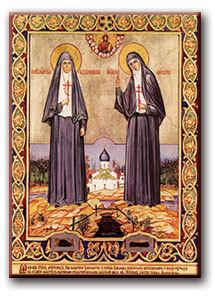On the Translation of the Relics of Holy Martyrs
Grand Duchess Elizabeth and Nun Barbara
(Towards the 35th anniversary of their Canonization
by the Russian Orthodox Church Outside of Russia)
 In preparing for the Act of Canonization of the Holy New Martyrs and Confessors of Russia, the Council of Bishops of the Russian Orthodox Church Outside of Russia decreed to exhume the coffins of Grand Duchess Elizabeth and her aide Nun Barbara in order to examine their remains, the only New Martyrs buried outside of Russia. In preparing for the Act of Canonization of the Holy New Martyrs and Confessors of Russia, the Council of Bishops of the Russian Orthodox Church Outside of Russia decreed to exhume the coffins of Grand Duchess Elizabeth and her aide Nun Barbara in order to examine their remains, the only New Martyrs buried outside of Russia.
A commission headed by Archimandrite Anthony (Grabbe) fulfilled the instructive of the ecclesiastical authority and opened the crypts. It turned out that both martyrs were enclosed by five coffins: an oak-wood coffin, inside which were zinc, wooden, zinc and metal coffins.
In one of the zinc coffins, and on the outside of the external wooden coffins were inscriptions which read “The body of Grand Duchess Elizaveta Feodorovna, murdered by bandits of the Soviet state…” Other fragments contained words, including several surnames (of the murderers?) and the final words: “…buried on October 19, 1918.”
When the last, inner coffin containing the Grand Duchess’ remains was opened, a wondrous aroma filled the area, as described by Fr Anthony: “a strong aroma like honey and jasmine mixed together.” This was noticed by everyone in attendance. The aroma lingered even after the area was aired out, which demonstrated that it was not simply the air inside the coffins that bore the aroma, but the relics themselves.
The other thing that amazed Fr Anthony and the monastics with him was the state of the garments of the martyrs. The fabric was moist throughout, as though soaked in some liquid substance. The coffins had been sealed shut, and the earth in Gethsemane Convent was dry. The source of the moisture, then, were the relics themselves. Later, when a portion of the relics were placed in reliquaries and covered with plexiglass, the inside of the latter became covered in moisture. It is logical to assume, then, that the relics of St Elizabeth and St Barbara were giving off myrrh.
There was yet another discovery made by the commission. A paraman (monastic) cross was found on the chest of the Grand Duchess, meaning she had been secretly tonsured to monasticism. It is most likely that she was tonsured by Metropolitan Vladimir, the first of the Russian New Martyrs.
The relics of both martyrs are uncorrupt to this day. Archimandrite Anthony, with piety and trepidation, separated the hands of the relics and placed them in a separate reliquary, the remains themselves dressed in new garments and placed in sealed coffins. The reliquary was then brought to the Synodal Cathedral of Our Lady “of the Sign” in New York City by Fr Anthony.
Soon after the opening, or translation, of the relics, His Beatitude Patriarch Diodoros of Jerusalem and All Palestine visited Gethsemane Convents. After praying before the crypts of St Elizabeth and St Barbara, and venerating them, the Primate of the most ancient of all Churches, “The Mother of Christianity,” uttered the words: “Undoubtedly, these holy martyrs and by their prayers the Lord Himself will help the Church of Jerusalem and the Russian Church.”
“V.S.”, a participant.
Pravoslavnaya Rus, No. 20, 1981.
|